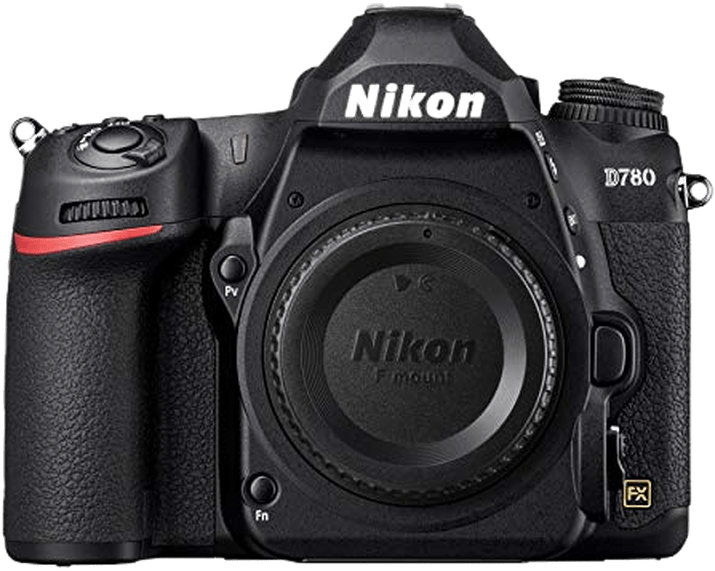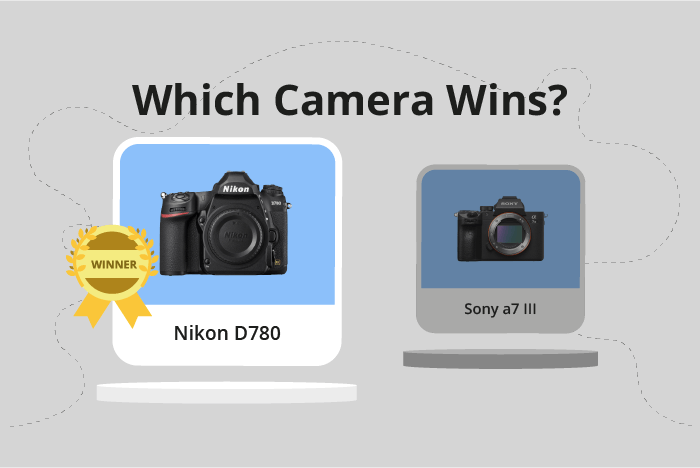Nikon D780 vs Sony a7 III Comparison
Nikon D780

Sony a7 III

The Nikon D780 edges out the Sony a7 III by just one point, scoring 81/100 compared to the Sony’s 80/100. Both cameras share some common specs, such as their release year and camera type: the D780 is a DSLR released in 2020, while the a7 III is a mirrorless camera released in 2018.
The Nikon D780 has a few advantages, including a larger body (144 x 116 x 76mm) and a higher launch price of $2299, which could suggest better features or build quality. However, the Sony a7 III is lighter, weighing only 650g compared to the D780’s 850g, making it more portable and easier to handle for extended periods.
Taking these factors into account, the Nikon D780 may be more suitable for those who prioritize a larger camera with potentially better features, while the Sony a7 III may appeal to users who value a lighter and more compact option.
Nikon D780 vs Sony a7 III Overview and Optics
The Sony a7 III wins the optics comparison with a score of 81/100, while the Nikon D780 scores 77/100. Both cameras share several specifications, such as a CMOS sensor, full-frame sensor size, and similar megapixel counts (25 for the Nikon D780 and 24.2 for the Sony a7 III). Additionally, the cameras have comparable shooting speeds, with the Nikon D780 at 12 and the Sony a7 III at 10.
The Sony a7 III has advantages over the Nikon D780, including image stabilization and a slightly higher score for optics. Image stabilization is a valuable feature for photographers, as it reduces camera shake and results in sharper images. The Sony a7 III’s lens mount is Sony FE, providing access to a wide range of high-quality lenses.
On the other hand, the Nikon D780 has a higher DXOMARK score for the sensor (97) compared to the Sony a7 III (96), indicating better overall image quality. The Nikon D780 also has a faster shooting speed (12) than the Sony a7 III (10), which can be beneficial for capturing fast-moving subjects. The Nikon D780’s lens mount is Nikon F, which also offers a vast selection of lenses to choose from.
In the optics comparison, the Sony a7 III takes the lead due to its image stabilization feature and slightly superior optics score. However, the Nikon D780 should not be overlooked, as it boasts a higher sensor score and faster shooting speed. Both cameras have their strengths, and the choice between them depends on the photographer’s priorities and preferences.
Nikon D780 vs Sony a7 III Video Performance
The Nikon D780 outperforms the Sony a7 III in video capabilities, scoring 91 out of 100 compared to the Sony’s 56. Both cameras share common specifications, including 4K maximum video resolution and video dimensions of 3840 x 2160. However, the Nikon D780 offers superior features that contribute to its higher score.
The D780 boasts a higher maximum video frame rate of 120fps, while the a7 III only reaches 30fps. This difference allows the Nikon to capture smoother and more detailed slow-motion footage, providing an advantage for videographers who require this functionality. Furthermore, the Nikon D780 has built-in time-lapse functionality, which the Sony a7 III lacks. This feature enables users to create dynamic time-lapse videos without additional equipment or software, adding convenience and versatility to the D780’s video capabilities.
On the other hand, the Sony a7 III does not offer significant advantages over the Nikon D780 in terms of video capabilities. Both cameras share the same maximum video resolution and dimensions, but the a7 III falls short in frame rate and time-lapse functionality.
Considering the Nikon D780’s higher video score, faster frame rate, and built-in time-lapse capability, it is the clear winner in terms of video performance. The Sony a7 III, while still offering 4K resolution, does not provide the same level of versatility and functionality as the D780. Videographers in search of a camera with strong video capabilities should opt for the Nikon D780.
Nikon D780 vs Sony a7 III Features and Benefits
The Nikon D780 takes the lead in features with a score of 87/100, while the Sony a7 III follows closely with a score of 81/100. Both cameras share several specifications, including a touchscreen, flip screen, WIFI, and Bluetooth connectivity. However, neither camera offers GPS functionality.
The Nikon D780 surpasses the Sony a7 III in screen size and resolution. With a 3.2-inch screen and a resolution of 2,359,000 dots, the D780 provides a larger and sharper display than the a7 III’s 3-inch screen with 921,600 dots. This difference allows the D780 to deliver a better user experience when composing and reviewing images.
Although the Sony a7 III has a lower feature score, it still offers some advantages. The a7 III is a mirrorless camera, which makes it lighter and more compact than the D780, a DSLR. This design difference may be beneficial for photographers who prioritize portability and weight over other features.
The Nikon D780 excels in terms of features, outperforming the Sony a7 III in screen size and resolution. This makes the D780 an excellent choice for photographers who value image composition and review. On the other hand, the Sony a7 III’s mirrorless design offers benefits in terms of portability and weight, making it a suitable option for those who place a higher emphasis on these factors. Both cameras provide a range of features, such as a touchscreen, flip screen, WIFI, and Bluetooth connectivity, making them versatile choices for photographers with varying preferences.
Nikon D780 vs Sony a7 III Storage and Battery
The Nikon D780 triumphs over the Sony a7 III in the storage and battery category, scoring a remarkable 97 out of 100 points, compared to the Sony a7 III’s 68 points. Both cameras share the convenience of having two memory card slots and accepting SD/SDHC/SDXC cards. However, the Nikon D780 also supports faster UHS-II cards, while the Sony a7 III accommodates Memory Stick Duo/Pro Duo/Pro-HG Duo cards.
The Nikon D780 significantly outperforms the Sony a7 III in battery life, boasting an impressive 2260 shots per charge with its EN-EL15b battery. In contrast, the Sony a7 III’s NP-FZ100 battery only manages 750 shots per charge. Additionally, the Nikon D780 offers USB charging, giving users more flexibility when recharging their camera.
Despite the lower score in this category, the Sony a7 III does have an advantage in accepting a wider variety of memory card types. This could benefit users who already own Memory Stick Duo/Pro Duo/Pro-HG Duo cards.
Taking these factors into account, the Nikon D780 excels in the storage and battery department, offering superior battery life and faster memory card compatibility. The Sony a7 III, however, may still appeal to users who prefer its broader memory card support.
Nikon D780 vs Sony a7 III – Our Verdict
Are you still undecided about which camera is right for you? Have a look at these popular comparisons that feature the Nikon D780 or the Sony a7 III:

